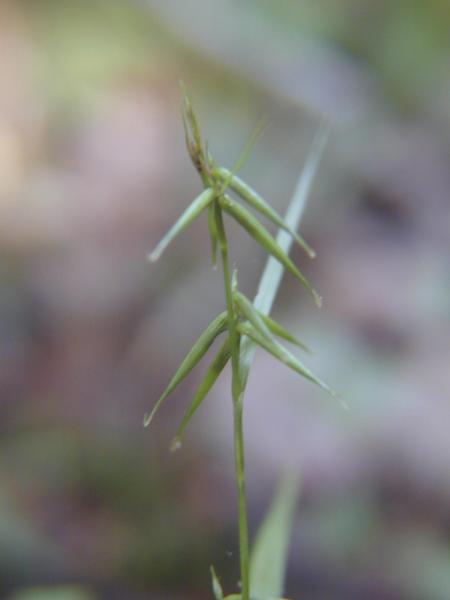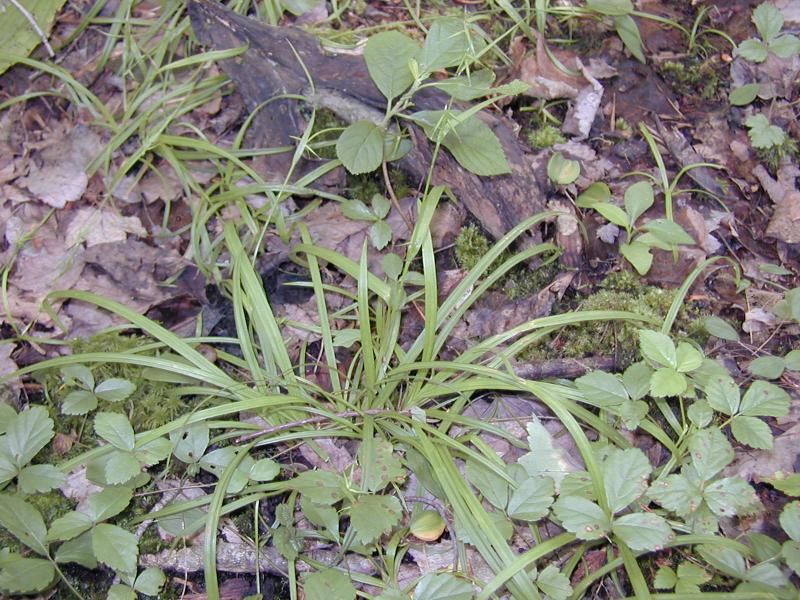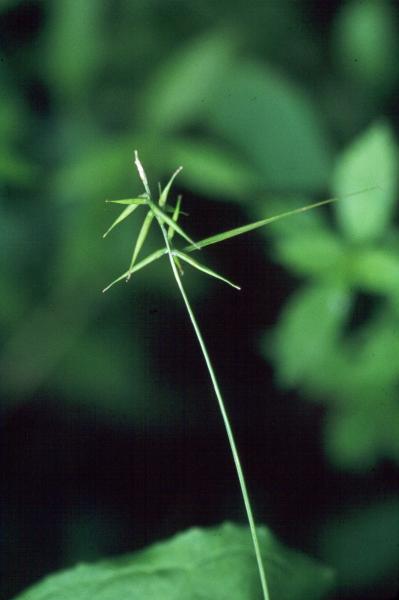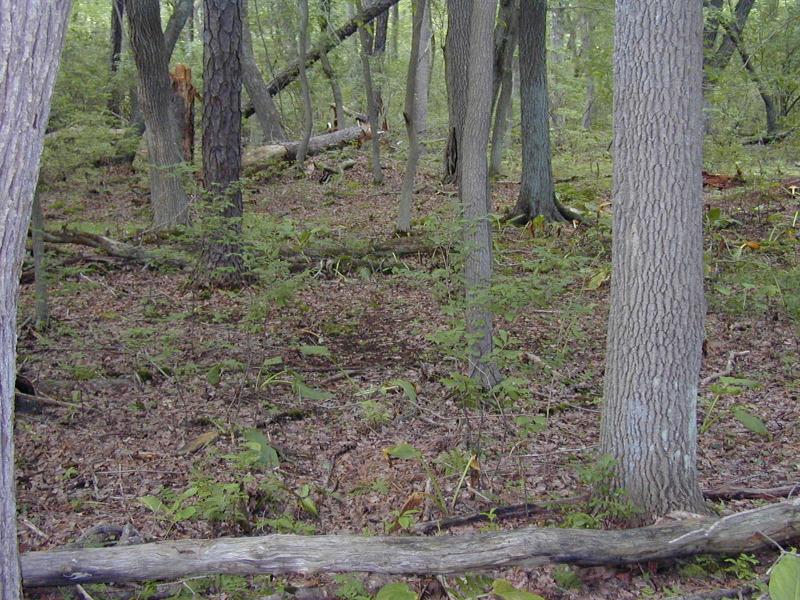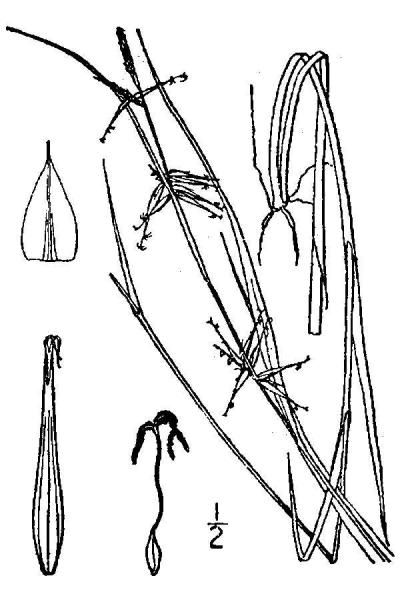Collins' Sedge
Carex collinsii Nutt.
- Class
- Monocotyledoneae (Monocots)
- Family
- Cyperaceae (Sedge Family)
- State Protection
- Endangered
Listed as Endangered by New York State: in imminent danger of extirpation in New York. For animals, taking, importation, transportation, or possession is prohibited, except under license or permit. For plants, removal or damage without the consent of the landowner is prohibited.
- Federal Protection
- Not Listed
- State Conservation Status Rank
- S1
Critically Imperiled in New York - Especially vulnerable to disappearing from New York due to extreme rarity or other factors; typically 5 or fewer populations or locations in New York, very few individuals, very restricted range, very few remaining acres (or miles of stream), and/or very steep declines.
- Global Conservation Status Rank
- G4
Apparently Secure globally - Uncommon in the world but not rare; usually widespread, but may be rare in some parts of its range; possibly some cause for long-term concern due to declines or other factors.
Summary
Did you know?
This species is named in honor of Zaccheus Collins who lived from 1764-1831 (Fernald 1970).
State Ranking Justification
There are four known populations and more than twenty historical locations, all restricted to Long Island and Staten Island. A number of the historical locations are either considered extirpated or have been surveyed without finding this plant. Only one site has more than a hundred culms. This site is actually quite large, possibly over a thousand culms, and it is the only site on protected land where management practices take the needs of this plant into account. This is a very unique looking sedge, making it difficult to overlook. Few to no new populations are expected.
Short-term Trends
There are only four populations that have been seen in recent years. One of these populations is quite large. The extent of the other populations is unknown or fairly small. No data is available on short-term trends for this species in New York. Therefore, short term trends are unknown.
Long-term Trends
Three populations are believed to have been extirpated sometime in the 1900's due to urbanization. A few other populations have been searched for without success. There are an additional about 15 populations that are only known from historical records. It is unknown if these populations are still extant. Carex collinsii is a very habitat specific plant. The habitat it occurs in is very limited in distribution. Overall, exact long-term trends are unknown but clearly show at least some decline.
Conservation and Management
Threats
Currently, no extant population appears to be directly threatened. Still, all known extant populations occur on Long Island which is undergoing a lot of development pressure. Some of these populations are protected but others are not. Additionally, adjacent development may negatively impact the hydrological regimes that are important for the habitat where Carex collinsii occurs.
Conservation Strategies and Management Practices
Currently no management is needed for C. collinsii.
Research Needs
All historical populations need to be surveyed. Some of the known extant sites also need to be surveyed to assess the full extent of these populations.
Habitat
Habitat
Carex collinsii occurs on Sphagnum in swamps on Long Island including pine barren and Chamaecyparis swamps. The swamps are dominated by Chamaecyparis thyoides or less frequently by Acer rubrum, Nysssa sylvatica, and/or Pinus rigida (New York Natural Heritage Program 2006). Shaded sphagnum bogs or seeps, characteristically under Chamaecyparis thyoides or Picea mariana (Standley 2002). Bogs, especially Chamaecyparis-swamps, mostly on the coastal plain (Gleason and Cronquist 1991). Sphagnum of springy wooded swamps (Fernald 1970).
Associated Ecological Communities
- Coastal plain Atlantic white cedar swamp
(guide)
A swamp that occurs on organic soils along streams and in poorly drained depressions of the coastal plain. Atlantic white cedar makes up over 50% of the canopy cover. In mixed stands in New York, red maple is the codominant tree.
- Highbush blueberry bog thicket*
(guide)
A wetland usually fed by rainwater or mineral-poor groundwater and dominated by tall shrubs and peat mosses. The most abundant shrub is usually highbush blueberry. The water in the bog is usually nutrient-poor and acidic.
- Red maple-blackgum swamp
(guide)
A maritime, coastal, or inland hardwood swamp that occurs in poorly drained depressions, sometimes in a narrow band between a stream and upland. Red maple and blackgum are often codominant or blackgum may be the dominant tree. Pitch pine may occur on drier hummock islands in pine barrens settings.
- Red maple-sweetgum swamp*
(guide)
A hardwood swamp that occurs on somewhat poorly drained seasonally wet flats, usually on somewhat acidic soils. Red maple-sweetgum swamps often occur as a mosaic with upland forest communities. Sweetgum is often the dominant tree or may be codominant with red maple. Other codominant trees include pin oak and blackgum.
* probable association but not confirmed.
Associated Species
- Acer rubrum
- Chamaecyparis thyoides (Atlantic white cedar)
- Clethra alnifolia (coastal sweet-pepperbush)
- Ilex verticillata (common winterberry)
- Nyssa sylvatica (black-gum, sour-gum)
- Pinus rigida (pitch pine)
- Rubus hispidus (swamp dewberry)
- Vaccinium corymbosum (highbush blueberry)
Range
New York State Distribution
In New York, Carex collinsii is only known from Long Island and Staten Island and is very close to the north edge of the species' range.
Global Distribution
Carex collinsii is mainly known from the coastal plain of the eastern United States but there are a few scattered inland populations as well. It occurs from Rhode Island, Connecticut, and New York south to Georgia (Mackenzie 1931-1935, Standley 2002).
Identification Comments
General Description
Collins' sedge is a tufted, grass-like perennial. Leaves mostly occur towards the lower part of the stems and are 5 mm wide. Stems are 17-75 cm tall and are terminated by a narrowly cylindrical cluster of male flowers. Secondary braches arise off of the main stems and are terminated by flower/fruit clusters (spikes). These spikes are composed of all female flowers or sometimes have a few male flowers at their summits. The female flowers develop into fruits (perigynia) which radiate out from the spikes, are 15 mm long and quite narrow, and are terminated by small hooks (Mackenzie 1931-1935, Standley 2002).
Identifying Characteristics
Carex collinsii is cespitose and short-rhizomatous. Basal leaf sheaths are purple-brown and the blades are 5 mm wide. Culms are 15-75 mm tall and the bracts are leaf-like and shorter than the inflorescences. There are 4-5 lateral pistillate or androgynous spikes. These lateral spikes are 6-10 flowered. The terminal spike is staminate and 5-10 mm long. Perigynia are subulate, green, red-brown spotted, 15 mm long, 1.2 mm wide, and taper gradually to an elongated beak. The perigynia beak is terminated by two teeth which are up to 1 mm long and reflex at maturity (Mackenzie 1931-1935, Standley 2002).
Best Life Stage for Proper Identification
It is easiest to identify C. collinsii when it has immature to mature perigynia.
Similar Species
Carex collinsii perhaps most resembles C. folliculata or C. michauxiana although it is quite distinct from these two species. It can be separated from these two by the perigynium beak teeth which are reflexed at maturity and the purple-brown basal leaf sheaths. In comparison, Carex folliculata and C. michauxiana have perigynium beak teeth straight and brown basal leaf sheaths.
Best Time to See
Carex collinsii starts to produce immature perigynia in late June. These mature and persist into mid August or a little later. The perigynia start to shed during the later part of this season. Therefore, the best time to survey for this species is July through early August.
- Fruiting
The time of year you would expect to find Collins' Sedge fruiting in New York.
Collins' Sedge Images
Taxonomy
Collins' Sedge
Carex collinsii Nutt.
- Kingdom Plantae
- Phylum Anthophyta
- Class Monocotyledoneae
(Monocots)
- Order Cyperales
- Family Cyperaceae (Sedge Family)
- Order Cyperales
- Class Monocotyledoneae
(Monocots)
- Phylum Anthophyta
Additional Common Names
- Sedge
Synonyms
- Carex michauxii Dewey [not Schweinitz 1824]
- Carex subulata Michx. [not J.F. Gmelin 1791]
Comments on the Classification
Carex collinsii is in the monotypic section Collinsiae and no intersectional hybrids are known. This section is perhaps closely related to Carex microglochin and has been placed by some authors in sections Folliculatae and Lupulinae (Standley 2002).
Additional Resources
Best Identification Reference
Gleason, Henry A. and A. Cronquist. 1991. Manual of Vascular Plants of Northeastern United States and Adjacent Canada. The New York Botanical Garden, Bronx, New York. 910 pp.
Other References
Fernald, M.L. 1950. Gray's manual of botany. 8th edition. D. Van Nostrand, New York. 1632 pp.
Holmgren, Noel. 1998. The Illustrated Companion to Gleason and Cronquist's Manual. Illustrations of the Vascular Plants of Northeastern United States and Adjacent Canada. The New York Botanical Garden, Bronx, New York.
Mackenzie, K.K. 1931-1935. Cariceae. North American Flora 18: 1-478.
New York Natural Heritage Program. 2010. Biotics database. New York Natural Heritage Program. New York State Department of Environmental Conservation. Albany, NY.
New York Natural Heritage Program. 2024. New York Natural Heritage Program Databases. Albany, NY.
Reschke, Carol. 1990. Ecological communities of New York State. New York Natural Heritage Program, New York State Department of Environmental Conservation. Latham, NY. 96 pp. plus xi.
Standley, L.A. 2002. Carex Linnaeus sect. Collinsiae (Mackenzie) Mackenzie. Page 517 in Flora of North America Editorial Committee (editors), Flora of North America, North of Mexico, Volume 23, Magnoliophyta: Commelinidae (in part): Cyperaceae. Oxford University Press, New York, NY, USA. 608pp + xxiv.
Weldy, T. and D. Werier. 2010. New York flora atlas. [S.M. Landry, K.N. Campbell, and L.D. Mabe (original application development), Florida Center for Community Design and Research http://www.fccdr.usf.edu/. University of South Florida http://www.usf.edu/]. New York Flora Association http://newyork.plantatlas.usf.edu/, Albany, New York
Links
About This Guide
Information for this guide was last updated on: May 21, 2006
Please cite this page as:
New York Natural Heritage Program. 2024.
Online Conservation Guide for
Carex collinsii.
Available from: https://guides.nynhp.org/collins-sedge/.
Accessed July 27, 2024.
